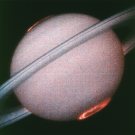
Space Telescope Imaging Spectrograph
Encyclopedia

Spectrograph
A spectrograph is an instrument that separates an incoming wave into a frequency spectrum. There are several kinds of machines referred to as spectrographs, depending on the precise nature of the waves...
, also with a camera mode, installed on the Hubble Space Telescope
Hubble Space Telescope
The Hubble Space Telescope is a space telescope that was carried into orbit by a Space Shuttle in 1990 and remains in operation. A 2.4 meter aperture telescope in low Earth orbit, Hubble's four main instruments observe in the near ultraviolet, visible, and near infrared...
. It operated continuously from 1997 until a power supply failure in 2004. After repairs, it began operating again in 2009. The spectrograph has made many important observations, including the first spectrum of the atmosphere of an extrasolar planet
Extrasolar planet
An extrasolar planet, or exoplanet, is a planet outside the Solar System. A total of such planets have been identified as of . It is now known that a substantial fraction of stars have planets, including perhaps half of all Sun-like stars...
, HD 209458b.
The STIS was installed on Hubble in 1997 during its second servicing mission (STS-82
STS-82
STS-82 was a Hubble Space Telescope servicing mission by Space Shuttle Discovery. The mission launched from Kennedy Space Center, Florida, on 11 February 1997 and returned to earth on 21 February 1997 at Kennedy Space Center.-Crew:...
) by Mark Lee
Mark C. Lee
Mark Charles Lee USAF Colonel, is a former NASA astronaut who flew on four Space Shuttle missions. He retired from the Air Force and NASA on July 1, 2001.-Early life:...
and Steven Smith
Steven Smith (astronaut)
Steven Lee Smith , is an American technology executive and NASA astronaut.-Education:Graduated from Leland High School, San Jose, California, in 1977; received a bachelor of science degree in electrical engineering in 1981; a master of science degree in electrical engineering in 1982; and a...
, replacing the High Resolution Spectrograph and the Faint Object Spectrograph
Faint Object Spectrograph
The Faint Object Spectrograph was a spectrograph installed on the Hubble Space Telescope. It was replaced by the Space Telescope Imaging Spectrograph in 1997, and is now on display in the National Air and Space Museum in Washington DC. -FOS facts:...
. It was designed to operate for five years. On August 3, 2004 an electronic failure rendered STIS inoperable, ending its use 2 years beyond its predicted lifespan. In order to bring it back to operational status, the instrument was repaired by space shuttle astronauts during STS-125
STS-125
STS-125, or HST-SM4 , was the fifth and final space shuttle servicing mission to the Hubble Space Telescope .Launch occurred on 11 May 2009 at 2:01 pm EDT...
, Servicing Mission 4, launched on May 11, 2009.
The STIS has three 1024×1024 detector arrays. The first is a charge-coupled device with a 52×52 arc-second field of view, covering the visible and near-infrared spectrum from 200 nm to 1030 nm. The other two detectors are Multi-Anode Multichannel Arrays, each with a 25×25 arc-second field of view. One is Cs2Te, and covers the near-UV between 160 nm and 310 nm. The other is CsI and covers the far-UV between 115 nm and 170 nm.
See also
- Wide Field and Planetary CameraWide Field and Planetary CameraThe Wide Field/Planetary Camera was a camera installed on the Hubble Space Telescope until December 1993. It was one of the instruments on Hubble at launch, but its functionality was severely impaired by the defects of the main mirror optics which afflicted the telescope...
- Wide Field and Planetary Camera 2Wide Field and Planetary Camera 2The Wide Field and Planetary Camera 2 is a baby grand piano sized camera built by the Jet Propulsion Laboratory and formerly installed on the Hubble Space Telescope. It was installed by servicing mission 1 in 1993, replacing the telescope's original Wide Field and Planetary Camera...
- Wide Field Camera 3Wide Field Camera 3The Wide Field Camera 3 is the Hubble Space Telescope's last and most technologically advanced instrument to take images in the visible spectrum...
- Cosmic Origins SpectrographCosmic Origins SpectrographThe Cosmic Origins Spectrograph is a science instrument that was installed on the Hubble Space Telescope during Servicing Mission 4 in May 2009. It is designed for ultraviolet spectroscopy of faint point sources with a resolving power of ≈1,550–24,000...
- Advanced Camera for SurveysAdvanced Camera for SurveysThe Advanced Camera for Surveys is a third generation axial instrument aboard the Hubble Space Telescope . The initial design and scientific capabilities of ACS were defined by a team based at Johns Hopkins University. ACS was assembled and tested extensively at Ball Aerospace & Technologies Corp...
- Near Infrared Camera and Multi-Object SpectrometerNear Infrared Camera and Multi-Object SpectrometerThe Near Infrared Camera and Multi-Object Spectrometer is a scientific instrument for infrared astronomy, installed on the Hubble Space Telescope , operating from 1997 to 1999, and from 2002 to 2008...
- Faint Object CameraFaint Object CameraThe Faint Object Camera was a camera installed on the Hubble Space Telescope from launch in 1990 until 2002. It was replaced by the Advanced Camera for Surveys.The camera was built by Dornier GmbH and was funded by the European Space Agency...

